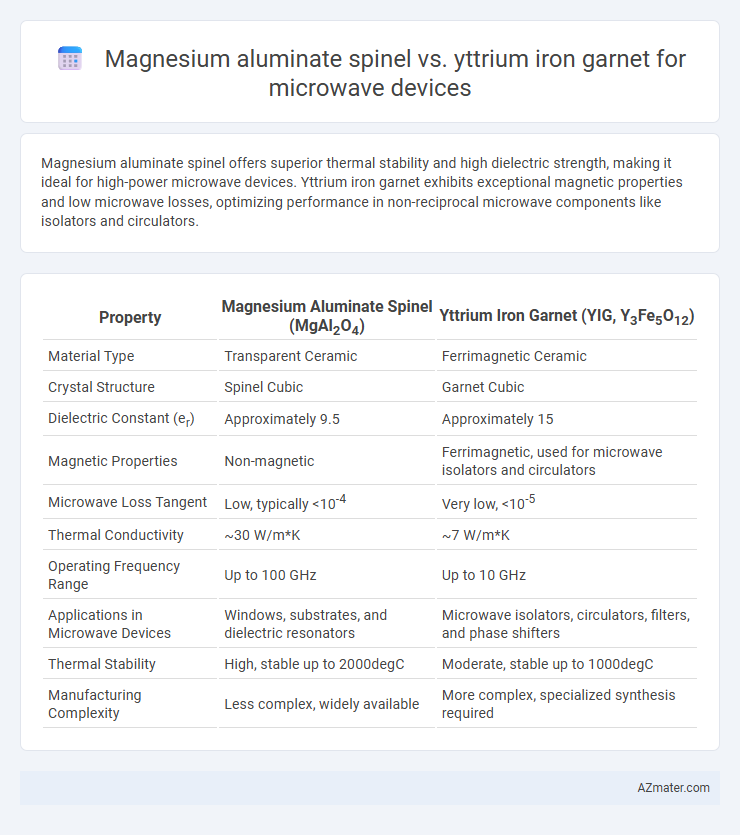Magnesium aluminate spinel offers superior thermal stability and high dielectric strength, making it ideal for high-power microwave devices. Yttrium iron garnet exhibits exceptional magnetic properties and low microwave losses, optimizing performance in non-reciprocal microwave components like isolators and circulators.
Table of Comparison
| Property | Magnesium Aluminate Spinel (MgAl2O4) | Yttrium Iron Garnet (YIG, Y3Fe5O12) |
|---|---|---|
| Material Type | Transparent Ceramic | Ferrimagnetic Ceramic |
| Crystal Structure | Spinel Cubic | Garnet Cubic |
| Dielectric Constant (er) | Approximately 9.5 | Approximately 15 |
| Magnetic Properties | Non-magnetic | Ferrimagnetic, used for microwave isolators and circulators |
| Microwave Loss Tangent | Low, typically <10-4 | Very low, <10-5 |
| Thermal Conductivity | ~30 W/m*K | ~7 W/m*K |
| Operating Frequency Range | Up to 100 GHz | Up to 10 GHz |
| Applications in Microwave Devices | Windows, substrates, and dielectric resonators | Microwave isolators, circulators, filters, and phase shifters |
| Thermal Stability | High, stable up to 2000degC | Moderate, stable up to 1000degC |
| Manufacturing Complexity | Less complex, widely available | More complex, specialized synthesis required |
Introduction to Microwave Device Materials
Magnesium aluminate spinel and yttrium iron garnet are critical materials used in microwave devices due to their distinct electromagnetic properties and thermal stability. Magnesium aluminate spinel offers high dielectric strength and low loss tangent, making it ideal for substrates and insulating components in microwave circuits. Yttrium iron garnet is prized for its superior magnetic properties and low microwave damping, which enhances signal processing in isolators, circulators, and filters within microwave communication systems.
Overview of Magnesium Aluminate Spinel
Magnesium aluminate spinel (MgAl2O4) is a highly durable ceramic material characterized by excellent thermal stability, mechanical strength, and low dielectric loss, making it ideal for microwave device substrates. Its cubic crystal structure and high dielectric constant enable efficient signal transmission with minimal energy dissipation at microwave frequencies. Compared to yttrium iron garnet (YIG), magnesium aluminate spinel offers superior hardness and corrosion resistance, enhancing device longevity in harsh operating environments.
Properties of Yttrium Iron Garnet
Yttrium iron garnet (YIG) features exceptionally low microwave loss and high Q-factor, making it ideal for microwave device applications such as filters and oscillators. Its ferrimagnetic properties enable precise magnetic resonance tuning at microwave frequencies, providing superior signal stability and selectivity compared to magnesium aluminate spinel. YIG's temperature stability and low magnetic anisotropy further enhance device performance in high-frequency microwave systems.
Dielectric Characteristics Comparison
Magnesium aluminate spinel (MgAl2O4) exhibits a low dielectric loss tangent typically around 10^-4 to 10^-3 at microwave frequencies, making it highly suitable for high-Q dielectric resonators in microwave devices. Yttrium iron garnet (Y3Fe5O12) presents a moderate dielectric constant (~15) and higher magnetic permeability, offering tunable microwave absorption properties, but it generally has higher dielectric losses compared to spinel. The superior dielectric stability and lower loss tangent of magnesium aluminate spinel optimize signal integrity and minimize energy dissipation in microwave applications, while YIG's magneto-dielectric properties are advantageous for tunable filters and isolators.
Magnetic Properties and Performance
Magnesium aluminate spinel (MgAl2O4) exhibits low magnetic permeability and minimal microwave losses, making it suitable for applications requiring low dielectric loss but limited magnetic functionality. Yttrium iron garnet (Y3Fe5O12) demonstrates superior magnetic properties, including high permeability, low damping, and tunable ferromagnetic resonance, which enhance microwave device performance in filters and isolators. The magnetic loss tangent of YIG is significantly lower than that of spinel, enabling higher Q-factors and more efficient signal processing at microwave frequencies.
Thermal Stability and Reliability
Magnesium aluminate spinel exhibits superior thermal stability with a melting point around 2135degC, making it highly reliable for high-temperature microwave device applications compared to yttrium iron garnet (YIG), which has a lower thermal tolerance near 1970degC. Spinel's excellent chemical inertness and mechanical robustness enhance long-term device reliability under thermal cycling and harsh environments, whereas YIG is more susceptible to thermal degradation and magnetic property variations at elevated temperatures. These thermal performance differences render magnesium aluminate spinel preferable for microwave components requiring stable dielectric properties and minimal signal loss under extreme thermal conditions.
Microwave Losses: Spinel vs. YIG
Magnesium aluminate spinel exhibits lower dielectric loss at microwave frequencies compared to yttrium iron garnet (YIG), making it advantageous for applications requiring minimal signal attenuation. YIG, while offering tunable magnetic properties and low magnetic losses, tends to have higher dielectric losses under similar conditions. The superior microwave loss performance of spinel enhances device efficiency and signal clarity in high-frequency microwave components.
Material Fabrication and Processing
Magnesium aluminate spinel (MgAl2O4) exhibits superior mechanical strength and thermal stability, making it ideal for microwave device substrates fabricated through solid-state reaction or sol-gel techniques ensuring high density and minimal porosity. Yttrium iron garnet (Y3Fe5O12) requires precise control of stoichiometry during liquid phase epitaxy or pulsed laser deposition to achieve optimal magnetic properties essential for microwave performance. Fabrication of MgAl2O4 focuses on achieving optical transparency and electrical insulation, while YIG processing prioritizes magnetic uniformity and low microwave loss tangent.
Application Suitability in Microwave Devices
Magnesium aluminate spinel (MgAl2O4) offers excellent dielectric properties, such as low dielectric loss and high thermal stability, making it highly suitable for microwave substrates and insulating components in high-frequency devices. Yttrium iron garnet (YIG) possesses superior magnetic properties and low microwave resonance losses, ideal for tunable microwave filters, phase shifters, and ferrite isolators. The choice between MgAl2O4 and YIG hinges on whether the application demands dielectric performance or magnetic tunability in microwave devices.
Conclusion: Optimal Choice for Microwave Applications
Magnesium aluminate spinel offers superior thermal stability and mechanical robustness, making it ideal for high-power microwave device substrates requiring durability and efficient heat dissipation. Yttrium iron garnet excels in magnetic properties and low microwave losses, optimizing performance in tunable filters and isolators. For applications prioritizing thermal management and structural integrity, magnesium aluminate spinel is optimal, whereas yttrium iron garnet is preferred for devices demanding enhanced magnetic functionality and low insertion loss.

Infographic: Magnesium aluminate spinel vs Yttrium iron garnet for Microwave device
 azmater.com
azmater.com